General Information for Guides
Welcome to Ramat Hanadiv.
Thank you for choosing to come with your group to Ramat Hanadiv
We’ve gathered the most relevant information for your convenience, so you can enjoy and make the most of your visit here.
 News and Events
News and Events
Welcome to Ramat Hanadiv.
Thank you for choosing to come with your group to Ramat Hanadiv
We’ve gathered the most relevant information for your convenience, so you can enjoy and make the most of your visit here.
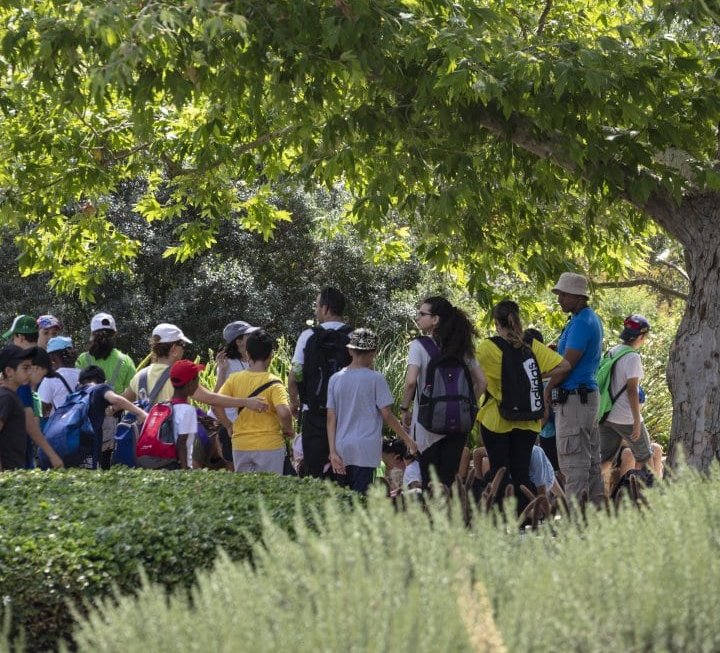
Logistic Information
Visiting hours
Sunday – Thursday 08:00 – 16:00
Friday 08:00 – 14:00
Saturday 08:00 – 16:00 (the crypt plaza is closed)
Viewing the Film “Beyond the Gardens”
The film “Beyond the Gardens” describes the history of the Rothschild family and the role of the Known Benefactor in the establishment of Jewish settlement in the Land of Israel, and presents the range of activities taking place in the Gardens and Nature Park of Ramat Hanadiv. The film lasts 15 minutes and it is screened every half hour. The film may be viewed free of charge but group viewings require advance booking. A viewing may be booked using the following online visiting arrangement. You can book a viewing of the film with subtitles in English, French or Russian.
You must be at the film hall about five minutes before the screening.
Services for group visits: Carpark for buses, Large restroom building next to the bus carpark, Shaded picnic grove with KKL-JNF benches and water fountains, Shaded meeting point for group explanations – next to the bus carpark, Kiosk/restaurant
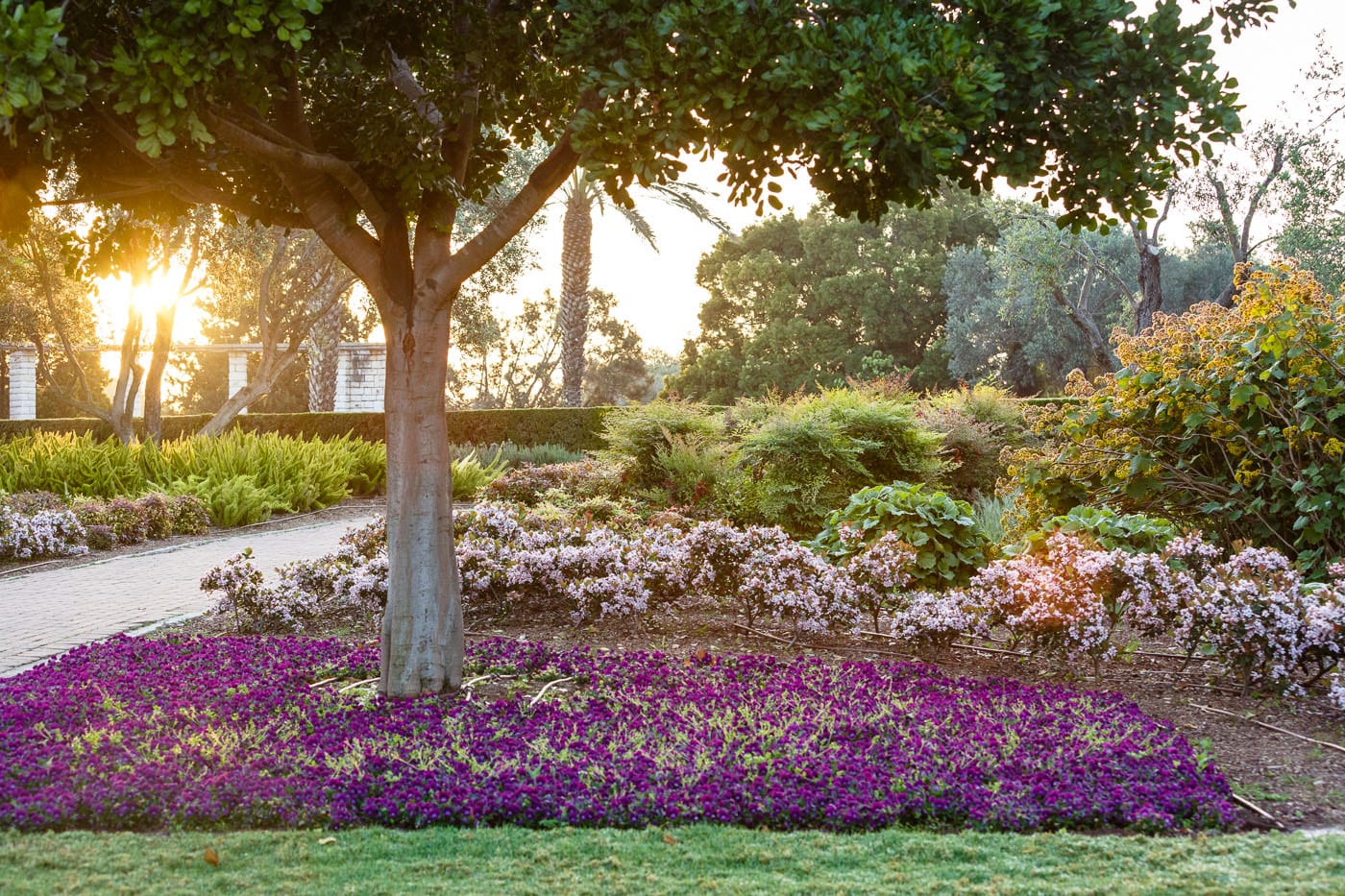
Ramat Hanadiv – Introduction
On the southern tip of Mt. Carmel, between Zihkron Ya’akov and Binyamina, lies Ramat Hanadiv. In April 1954 the Israeli Government decided to bring Baron Benjamin Edmond de Rothschild and his wife Baroness Ada Adelaide de Rothschild to eternal rest with a state funeral, twenty years after their passing. The Baron asked to be buried at the heart of one of the regions most populated with settlements that he had helped to establish. In 1958 the “Ramat Hanadiv Act” was passed, determining that Ramat Hanadiv will maintain these lands and manage them as a public garden and park dedicated to the memory of Baron Rothschild.
Since then, Ramat Hanadiv serves as a living memorial to the legacy of the Baron, who is known as ‘The Known Benefactor’ and ‘The Founding Father of the Yishuv’ and to his work.
In 1936, the Baron’s son, James de Rothschild, and his wife Dorothy, initiated the establishment of the Memorial Gardens. The mountain that was known as Umm el-Aleq was chosen to be the location for planting the gardens, due to its beauty and its location among the Baron’s moshavot (early Jewish agricultural settlements).
Vision of Ramat Hanadiv

Ramat Hanadiv, a living memorial to Baron Benjamin Edmond de Rothschild, operating for the benefit of the Israeli public as a whole and for generations to come. Ramat Hanadiv plays a leading role in the management of natural and cultural resources based on sustainable interactions between man, nature and the environment, and encourages understanding and appreciation of this ideal.

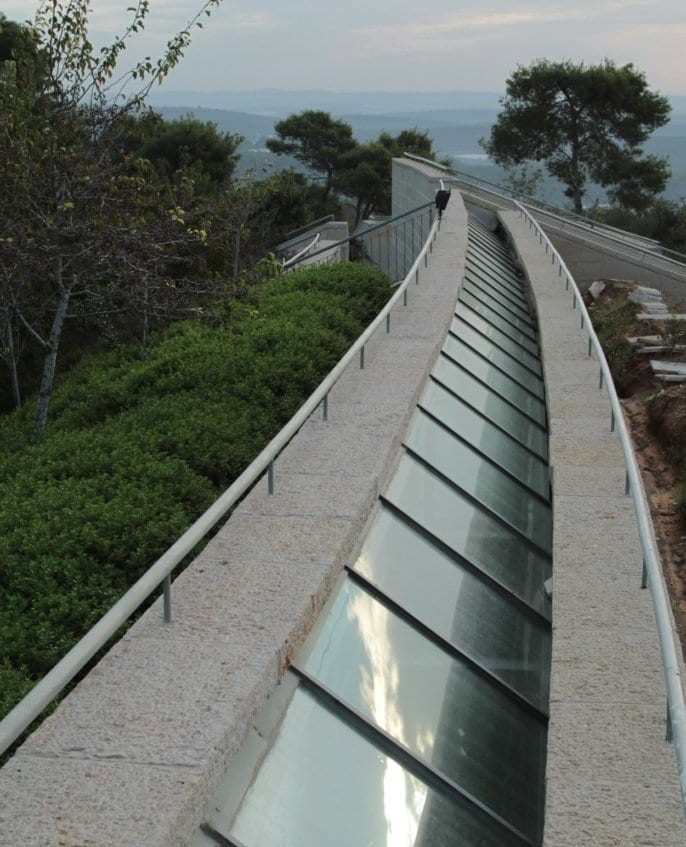
The Visitors Pavilion
The Visitors Pavilion was planned along two axes: a longitudinal landscape axis, which connects the Memorial Gardens to the Nature Park, and a lateral axis, built as a green hill covered with vegetation that surrounds the entrance plaza to the Gardens.
Running along the length of the building is a narrow glass skylight in the roof that provides natural lighting.
The building was planned by Ada Karmi Architects and Designers, and is the first public building in Israel to be certified as a ‘green building’.
Its construction emphasized saving energy, blending with the landscape and minimising effects on the environment.
Construction of the Visitor Pavilion put emphasis on the design of the entrance plaza.
A long narrow pond was built with its water pouring out of a stone relief, which was created, like all the sculptures in the Gardens, by the artists Israel and Rhoda Traub, from Zikhron Ya’akov, in 1954. The relief depicts a shell, a bunch of grapes, a bird, a fish and the sun, which represent the four elements of nature.
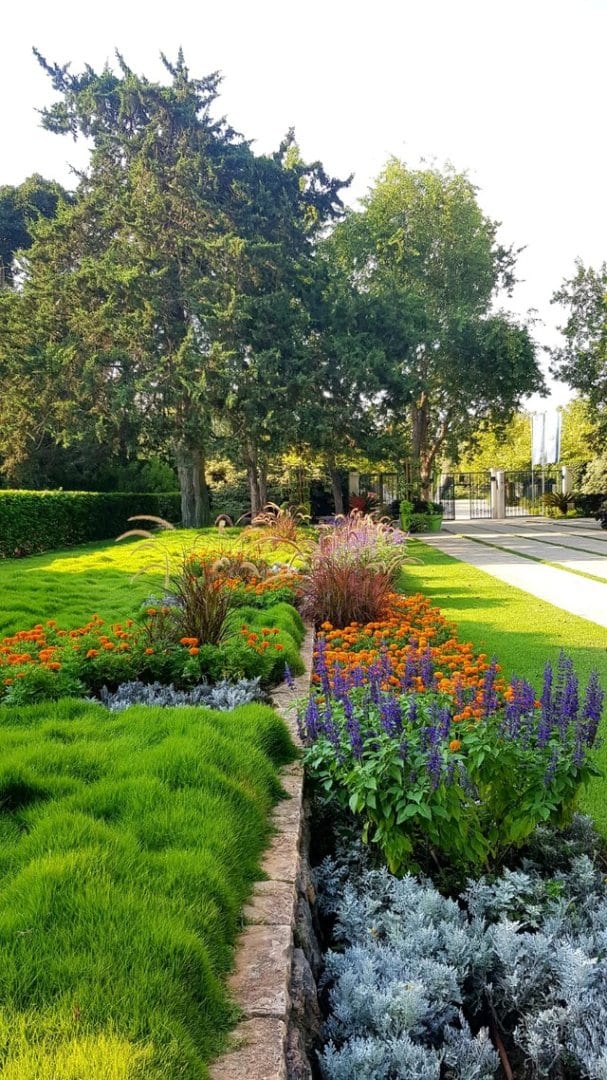
At the Garden Gates
The entrance gate made of iron welcomes visitors to the Memorial Gardens. Above it is the Rothschild family crest: a bronze shield supported on each size by a lion and a unicorn, symbols of power, topped by a crown of apples. The shield is divided into four quarters displaying reliefs of an eagle, a lion and a clenched fist holding five arrows, representing the five Rothschild brothers, the sons of Mayer Amschel Rothschild, head of the family. Baron Edmond Rothschild was the son of James, the youngest brother. The small shield symbolises their contribution to commerce. On the front of the Rothschild family house hung a red shield (‘rot schild’ in German), which with time became the family name. Under the shield appear the words ‘Concordia, Integritas, Industria’ – meaning unity, integrity, diligence – values that served as guiding principles for the family members.
Design of the Gardens
The establishment of the Gardens was initiated by Edmond James de Rothschild, the son of the Baron, in 1936, two years after the death of his father, who had expressed his desire to be buried in the soil of the Carmel. The site was chosen due to its beauty and its location – among the moshavot of the Baron. Fourteen of the country’s leading architects were invited to submit plans for the project. The architect Uriel (Otto) Schiller won the competition and invited the landscape architect Shlomo Weinberg (Oren) to join him in selecting the different vegetation compositions and their placement in the garden. Construction of the Memorial Gardens began in 1938, but was delayed by World War II and the War of Independence. On completion of the work, on April 6, 1954, a funeral ceremony was conducted and the Gardens were opened.
In the centre of the gardens stands the crypt surrounded by the different gardens. Meandering walking trails connect the gardens and invite visitors to wander around and discover the site’s secrets, each at their own pace. The trails traverse a range of different types of vegetation, lawns, fountains and ponds. The main principle guiding Uriel Schiller in his work was the contrast between two worlds – life and death. The site serves on one hand as a crypt, and on the other hand nurtures the aesthetics of life – flowering and nature, and many people visit it.
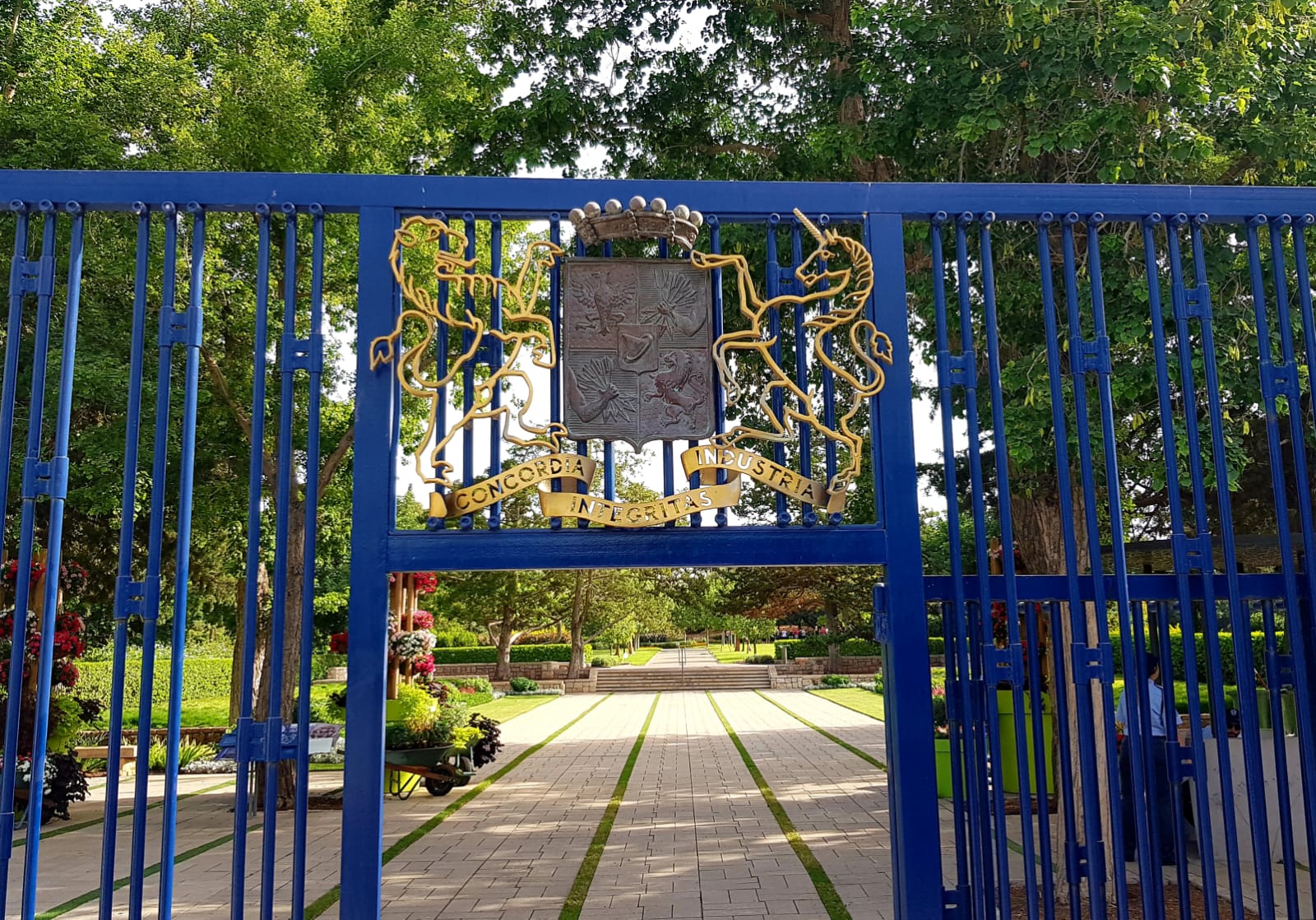
The principle of ‘contrast between worlds’ is expressed in different ways around the Gardens: games of light and shadow, closed spaces beside open expanses, a formal, meticulous gardening style beside freestyle gardening, and ornamental plants beside local wild plants. Water as a source of life takes on different forms in the Gardens, flowing through channels or bubbling in fountains that produce diverse sounds
The Entrance Plaza
Five strips stretch along the length of the entrance plaza and hint at the five sons – the successors of Mayer Amschel, founder of the Rothschild dynasty. Large Indian rosewood trees line the entrance plaza to the Gardens. An avenue of carob trees planted next to green expanses catches the eye. The path towards them ascends a flight of stairs, which seems to beckon to the visitors to climb up it into the heart of the Gardens, to the crypt.
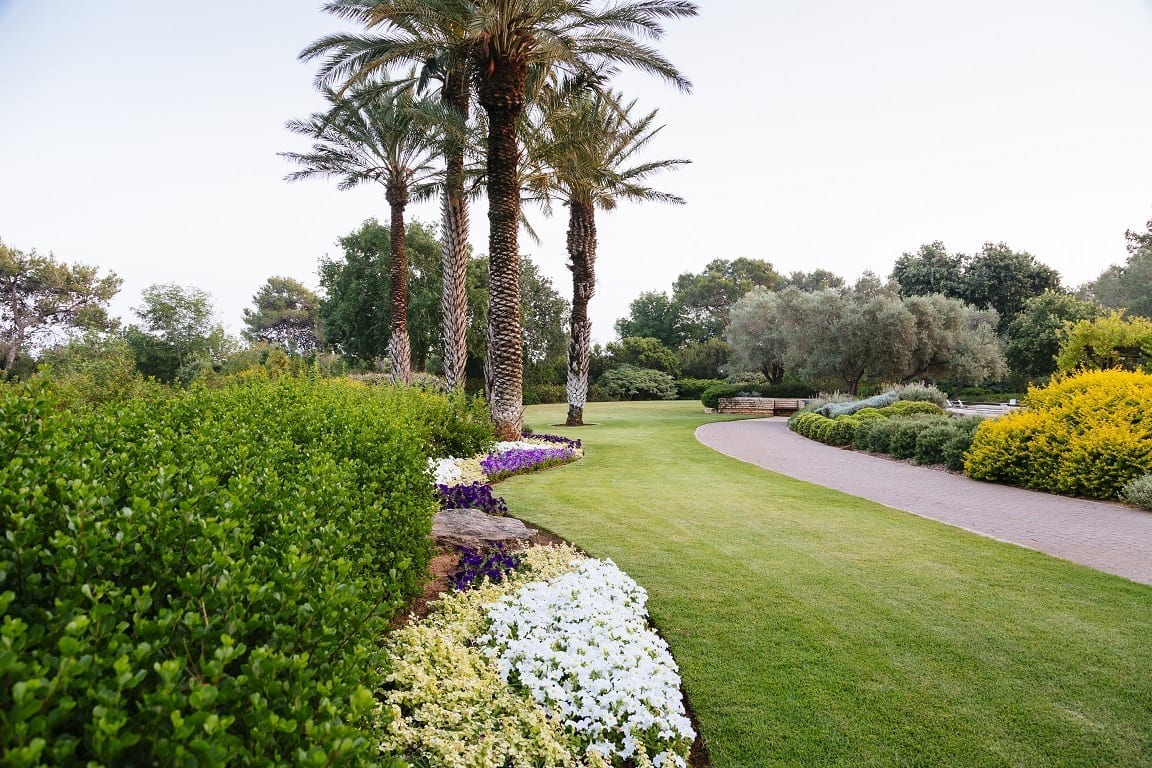
The Garden’s Trails
The network of trails leading from the entrance to the different parts of the Gardens ‘winks’ to the visitors and invites them to discover the Gardens’ secrets in myriad ways. Each trail provides access both to the crypt and to all of the gardens surrounding it. The walking trails pass between planted woodlands and wild areas, expansive lawns lead to shaded corners, colourful flowering carpets neighbor aromatic garden beds of herbs and aromatic plants. Ornamental ponds and seating corners hiding behind the climbers are scattered among the trails. The trails allow visitors to pass by ‘windows’ looking out over the landscape beyond the Gardens: the Mediterranean Sea, Zikhron Ya’akov, the Mountains of Samaria and the open landscape of the Nature Park.
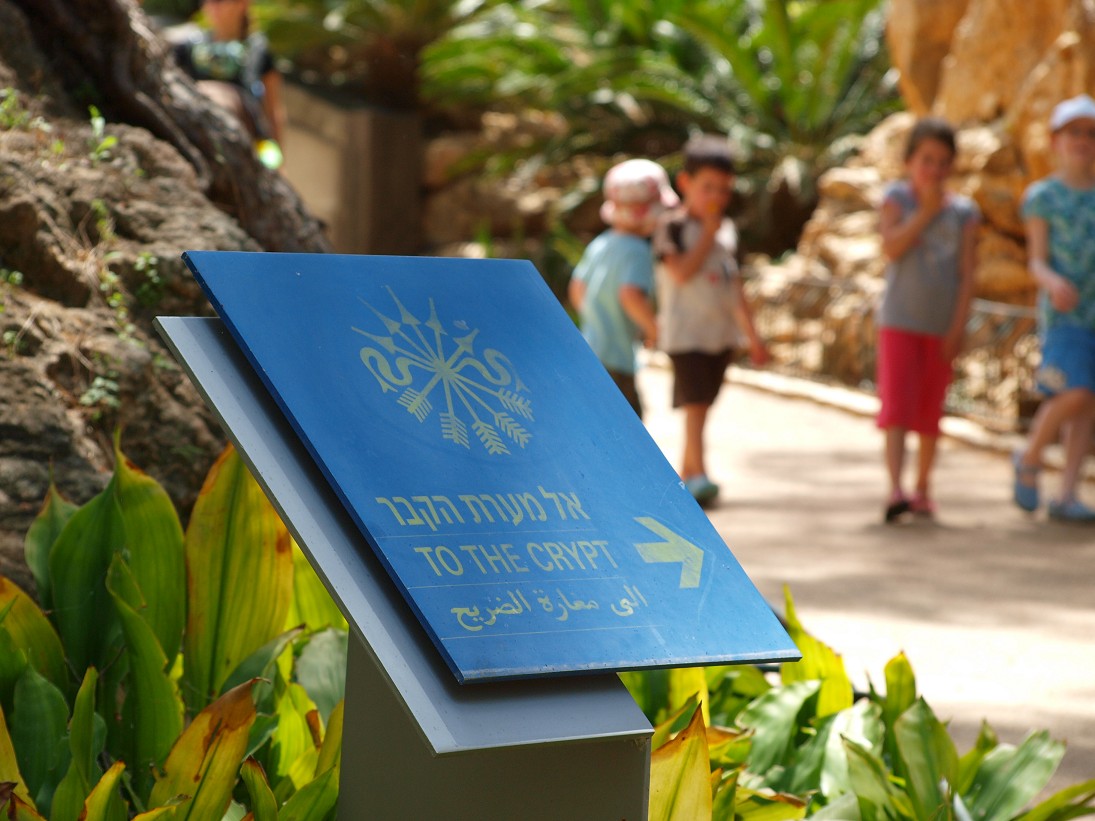
The Crypt
In the heart of the Gardens stands the crypt. An iron gate, adorned with bunches of grapes that symbolize the work of the Baron in the Land of Israel, welcomes the visitors. In the centre of the plaza leading to the crypt stands a large cypress tree, shaped like the flame of a memorial candle. Next to it stands the ‘Mug of Tears’ sculpture, of water-dripping stone. The crypt is carved into the rock, reminiscent of the customary Jewish burial structures from the Mishnaic and Talmudic periods. At the end of the crypt, inside a niche facing Jerusalem, stands the grave, made of black basalt. An ancient Star of David is affixed above the grave; it was brought from the traditional burial place of King David as a gift from the Antiquities Authority.
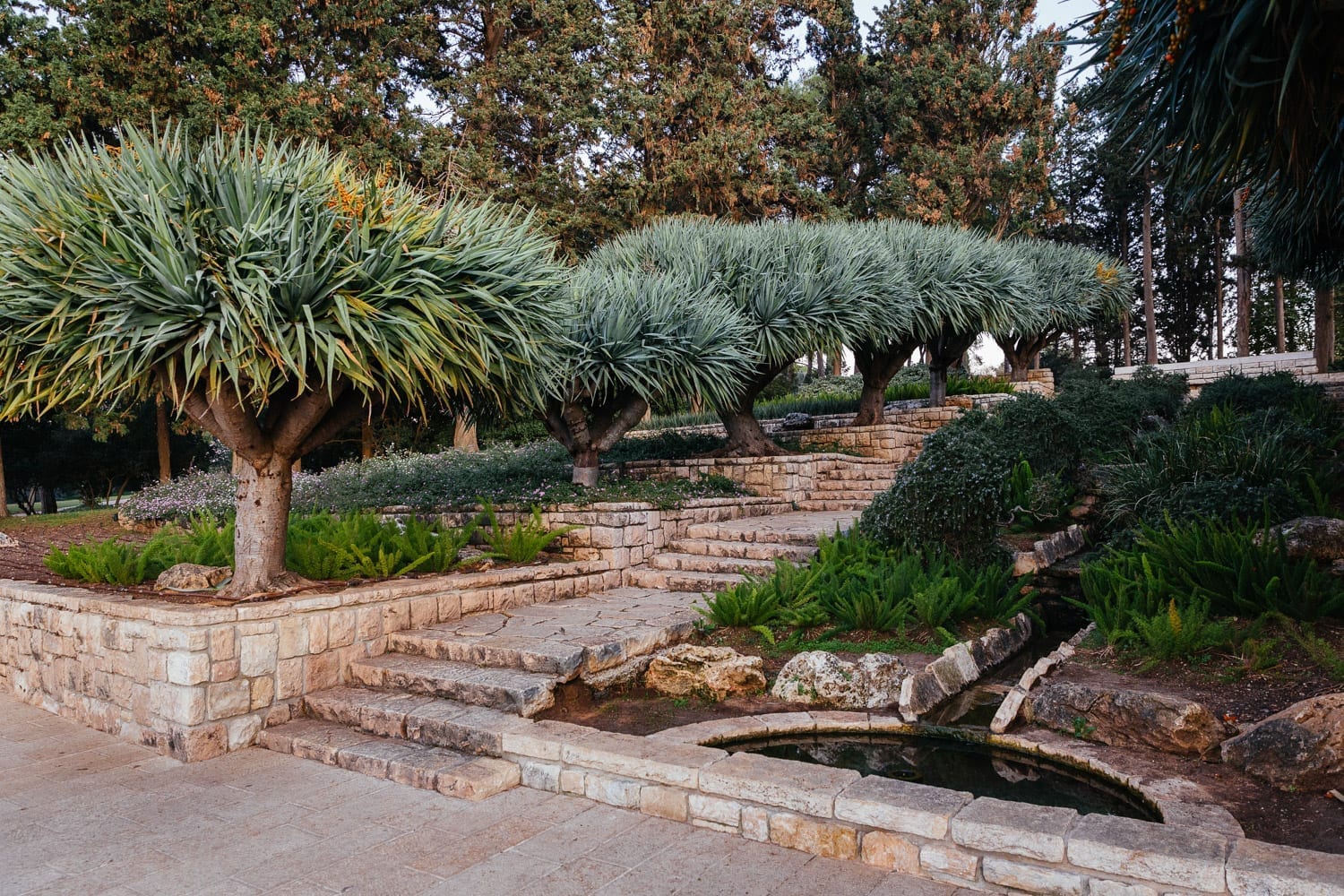
The Cascade Garden
This garden opens a window to the Mediterranean Sea.
At the top of the garden is a relief map showing the locations of the moshavot and other settlements that were founded and flourished with the support of the Baron.
A stream flows down the slope, through a series of terraces, to a pond. The pond is shaped in a semi-circle and on its edge is a sculpture of two hands attempting to grasp the flowing water, which represents time passing by.
Dragon trees, whose impressive shape catches the eye, are planted beside the flights of steps leading downwards.
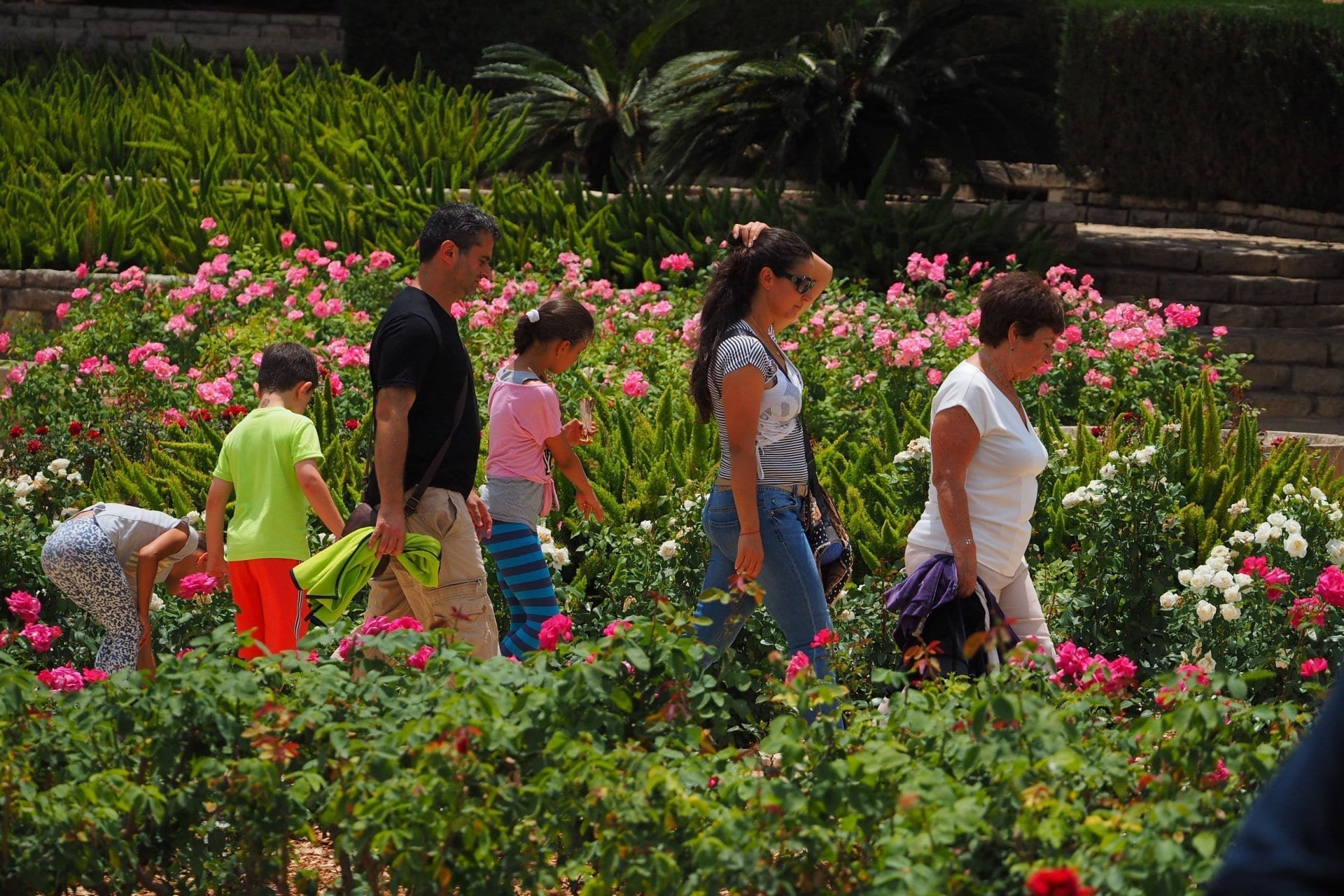
The Rose Garden
This garden, designed in the French style with all its aromas and colours, is the most meticulous and symmetric of the Gardens.
Different varieties of roses flower here during most seasons of the year, intoxicating in their fragrance and combination of shades.
Near a stone portico stands a sculpture of a woman kneeling down and holding a sundial in her hands – another symbol of the eternity of nature against the limits of time.

The Iris Garden
This young garden was established in 2010 as a rare collection of Oncocyclus irises. Due to accelerated development in recent years, open landscapes are shrinking, causing these irises to become rarer. Some of them are even in danger of extinction.
The garden is designed to include about 50 species growing in nature. The plants are gathered from disturbed habitats, transferred to a nursery at Ramat Hanadiv for acclimation, and subsequently planted permanently in the soil of the garden. The species in the garden flower from February to April, and as the years pass, their flowering will become stronger.
The garden serves as an example of combining wild vegetation in ornamental gadens; therefore, its gardening is low-maintenance and makes do with irrigation by rain.
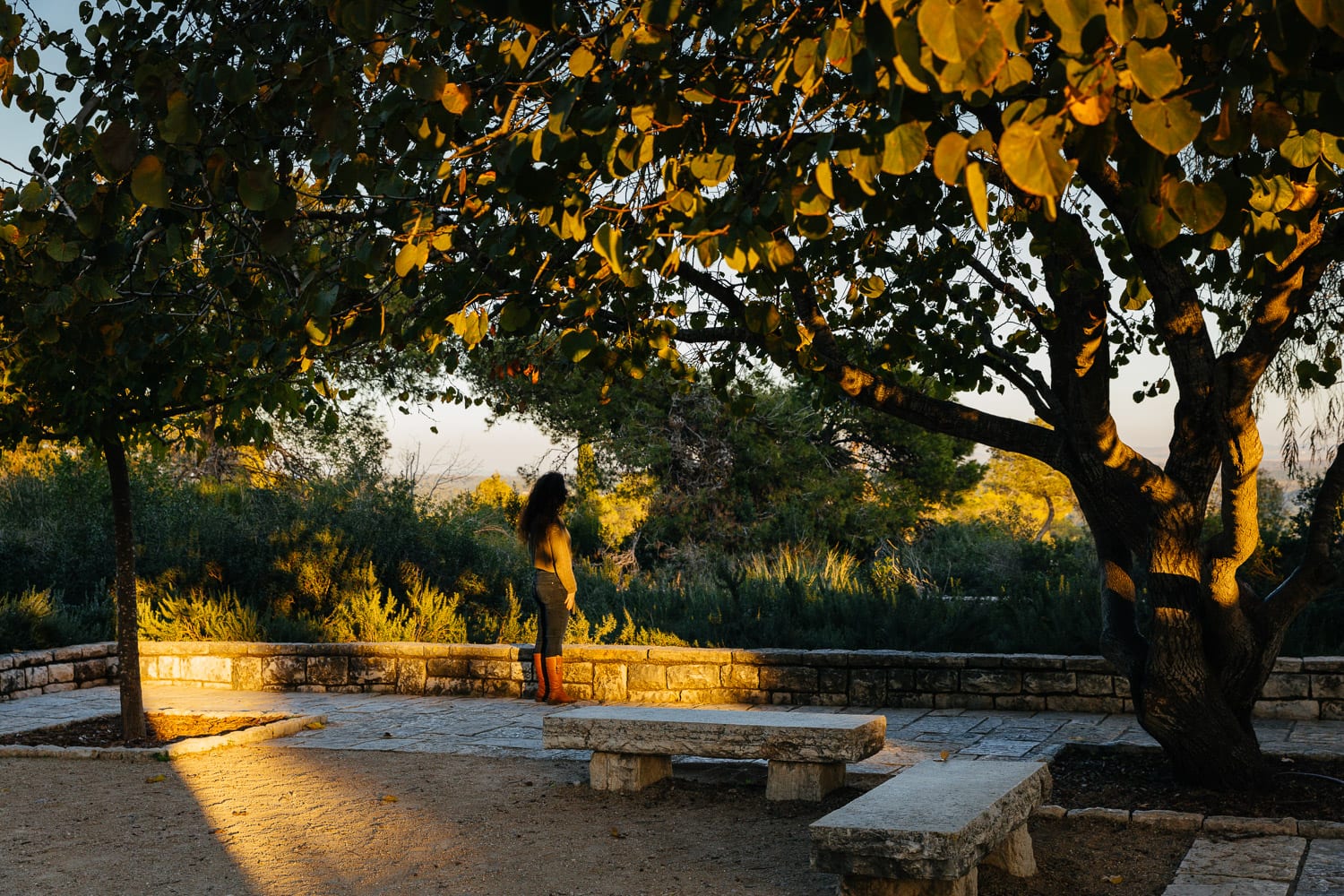
A View to Samaria and the Palm Garden
A plaza paved partly from stone, on the eastern side of the Gardens, provides a glimpse towards the Mountains of Samaria and the towns of Binyamina and Givat-Ada. These towns are named after the Baron (Benjamin) and his wife (Adelaide – Ada). The plaza meets the Palm Garden, which displays a modest representation of the many palm trees growing around the world. The most prominent of the garden’s palms is the Washingtonia palm. This palm was planted along the main streets of the Baron’s moshavot and has long been their commercial symbol.
Amphitheatre
Surrounded by shrubs, like a pearl, hides the amphitheatre; it was used in the past for the Rothschild Prize award ceremonies. Today, it hosts events that offer a musical experience in nature.
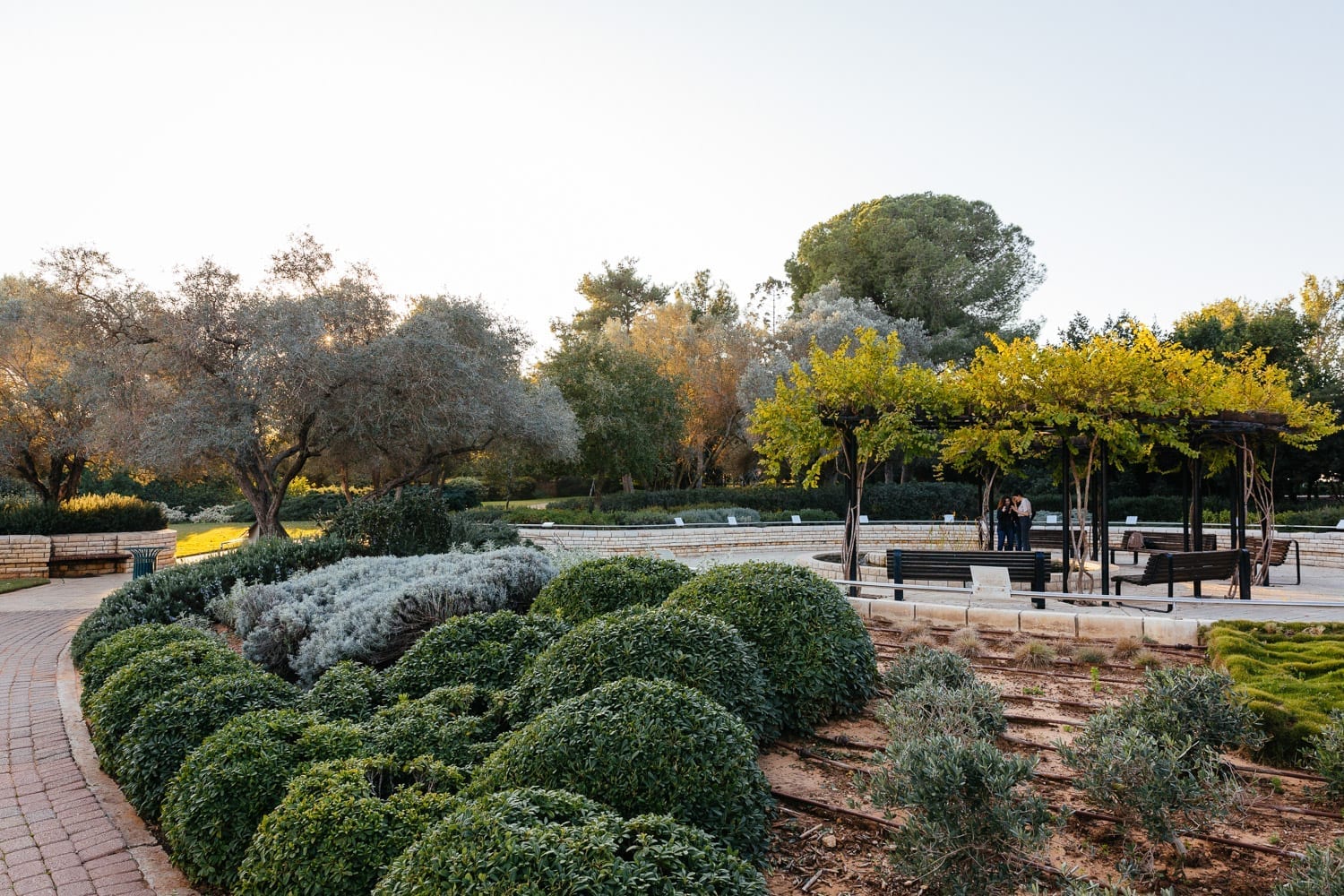
The Fragrance Garden
This garden arouses recognition of the beauty of nature through the senses of smell, touch and hearing. The garden abounds with plants that give off strong and unique fragrances, as well as those that arouse the sense of touch. A bubbling water fountain serves as a sound compass that hints at the location of the visitor with respect to the entrance.
Dorothy de Rothschild, the daughter-in-law of the Baron and his successor, looked for a way to also allow the blind and the sight-impaired to enjoy the site, and initiated the establishment of the Fragrance Garden.
The garden was designed by Miller Blum Environmental Planning and was opened to the public in 1988.
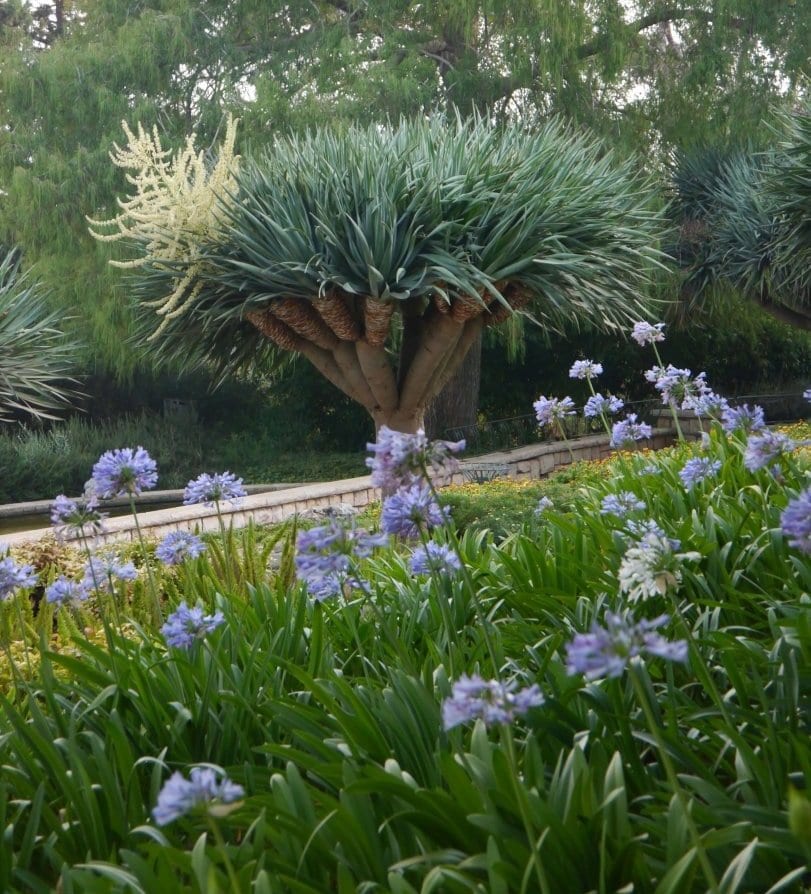
Gardening Quality
Gardening at Ramat Hanadiv combines values of professionalism, understanding and sensitivity. The planning takes into account the aesthetic value of the Gardens and their uniqueness in Israel, as well as ecological considerations.
The Gardens are nurtured with a minimum of chemical fertilisers, with preference for natural fertilisers and environmentally friendly pest control agents, in parallel with ongoing conservation of water. The feeling of an abundance of water is obtained using ponds, cascades and fountains, which flow within a closed water system.
The stone sculptures and wooden pergolas throughout the Gardens are made from local raw materials that blend into the natural texture of the environment and respect it. Prunings and garden refuse are crushed and become organic fertiliser that enriches the soil or ground cover that minimises evaporation.
The Memorial Gardens cover an area of 7 hectares, but less than half of this is garden area that requires ongoing maintenance and regular irrigation. The seasonal flower gardens are found in limited, but significant areas, such that they have an impressive impact but consume little water. Preference is given to the use of local and other vegetation that conserves water.
The seasonal flower gardens are found in limited, but significant areas, such that they have an impressive impact but consume little water. Preference is given to the use of local and other vegetation that conserves water.
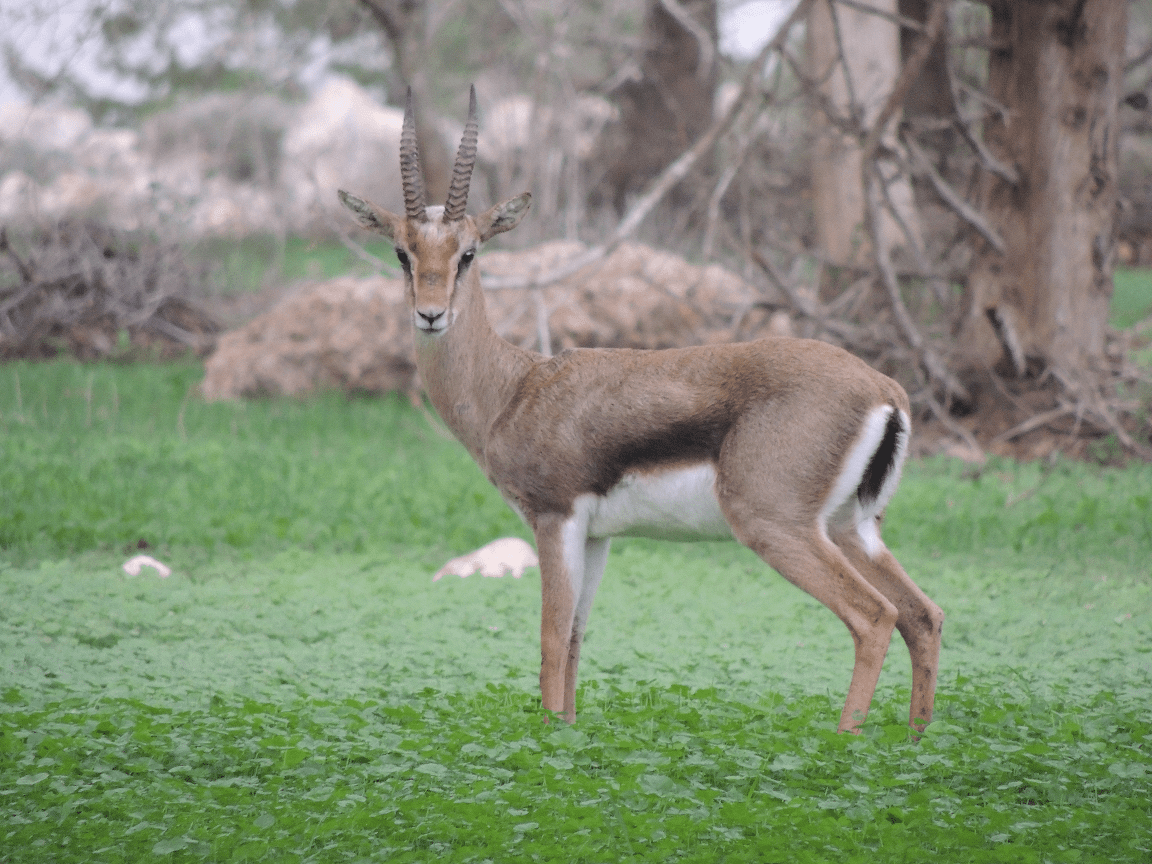
Nature also Visits the Gardens
The Memorial Gardens are located at the heart of an expansive Nature Park, which serves as a habitat for plants and wildlife. Windows to the open landscape of the Nature Park open in the gaps between the Gardens’ trees, linking between the two seemingly contrasting worlds. Neighbours from the Nature Park also show interest in the Gardens and they come to visit during both day and night. During the day butterflies are at the height of their activity: they identify nectar-rich flowers and plants that serve as safe havens for rearing their caterpillars. They are joined by a range of birds that find the garden vegetation to be rich in sources of food and places to hide and nest. At night, when darkness and silence fall on the Gardens, the visitors change. The howls of jackals, heard from a great distance, expose their nighttime jaunt on the meticulous lawns, porcupines find mouth-watering food in the fresh seedlings, and fruit bats enjoy the fruits of the different Ficus trees.
Any question? We will be glad to help
In the Nature Park at Ramat Hanadiv there are a number of spectacular hiking routes.
In 2015, Ramat Hanadiv established the Partnership for Regional Sustainability, aiming to combine forces for the quality of life in the region.
To complete your Ramat Hanadiv experience, you are cordially invited to enjoy the culinary pleasures of Mata’im, the cafe-restaurant on our premises.